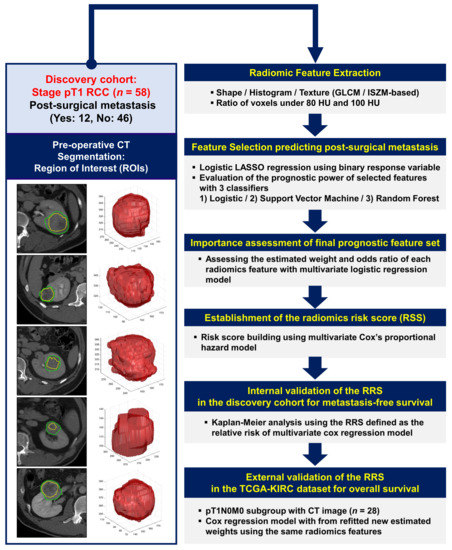
Cancers, Vol. 12, Pages 866: Integrative Radiogenomics Approach for Risk Assessment of Post-Operative Metastasis in Pathological T1 Renal Cell Carcinoma: A Pilot Retrospective Cohort Study
Cancers doi: 10.3390/cancers12040866
Authors:
Hye Won Lee
Hwan-ho Cho
Je-Gun Joung
Hwang Gyun Jeon
Byong Chang Jeong
Seong Soo Jeon
Hyun Moo Lee
Do-Hyun Nam
Woong-Yang Park
Chan Kyo Kim
Seong Il Seo
Hyunjin Park
Despite the increasing incidence of pathological stage T1 renal cell carcinoma (pT1 RCC), postoperative distant metastases develop in many surgically treated patients, causing death in certain cases. Therefore, this study aimed to create a radiomics model using imaging features from multiphase computed tomography (CT) to more accurately predict the postoperative metastasis of pT1 RCC and further investigate the possible link between radiomics parameters and gene expression profiles generated by whole transcriptome sequencing (WTS). Four radiomic features, including the minimum value of a histogram feature from inner regions of interest (ROIs) (INNER_Min_hist), the histogram of the energy feature from outer ROIs (OUTER_Energy_Hist), the maximum probability of gray-level co-occurrence matrix (GLCM) feature from inner ROIs (INNER_MaxProb_GLCM), and the ratio of voxels under 80 Hounsfield units (Hus) in the nephrographic phase of postcontrast CT (Under80HURatio), were detected to predict the postsurgical metastasis of patients with pathological stage T1 RCC, and the clinical outcomes of patients could be successfully stratified based on their radiomic risk scores. Furthermore, we identified heterogenous-trait-associated gene signatures correlated with these four radiomic features, which captured clinically relevant molecular pathways, tumor immune microenvironment, and potential treatment strategies. Our results of accurate surrogates using radiogenomics could lead to additional benefit from adjuvant therapy or postsurgical metastases in pT1 RCC.

Δεν υπάρχουν σχόλια:
Δημοσίευση σχολίου